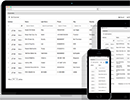In the end of this tutorial you will have a result that will look like this: [attachment=101:categories-and-sub.png]
Everything starts from the request of [member='vnt'] at: http://www.grocerycr...-grocery-croud/
So a quick solution for this is the below code ( You can also find the below code as a file at: [attachment=107:examples-categories-sub-categories.php]):
function categorie()
{
$crud = new grocery_CRUD();
$crud->set_table('vnt_categorie');
/* Add this customisation for parent_relation */
$primary_id_field = 'categoria_id';
$table_name = 'vnt_categorie';
$relation_field_name = 'parent_id';
$parent_field = 'parent_id';
$title_field = 'categoria';
$title_display_as = 'Select Categoria';
$where = array('stato'=>'1');//not required
$same_table = true; //not required, the default is false
$this->set_parent_relation($primary_id_field,$table_name,$parent_field,$title_field,$crud,$title_display_as,$relation_field_name,$where,$same_table);
/* ------------------------------------------- */
$output = $crud->render();
$this->_example_output($output);
}
function set_parent_relation($primary_id_field,$table_name,$parent_field,$title_field,$crud,$title_display_as,$relation_field_name,$where = null,$same_table = false)
{
$this->gc_id = $primary_id_field;
$this->gc_table = $table_name;
$this->gc_field_name = $relation_field_name;
$this->gc_parent = $parent_field;
$this->gc_title = $title_field;
$this->gc_where = $where;
$this->gc_title_display_as = $title_display_as;
$this->gc_same_table = $same_table;
$crud->set_css('assets/grocery_crud/css/jquery_plugins/chosen/chosen.css');
$crud->set_js('assets/grocery_crud/js/jquery-1.7.1.min.js');
$crud->set_js('assets/grocery_crud/js/jquery_plugins/jquery.chosen.min.js');
$crud->set_js('assets/grocery_crud/js/jquery_plugins/ajax-chosen.js');
$crud->set_js('assets/grocery_crud/js/jquery_plugins/config/jquery.chosen.config.js');
$crud->set_relation($this->gc_field_name,$this->gc_table,$this->gc_title);
$crud->callback_field($this->gc_field_name,array($this,'parent_relation_callback'));
}
function parent_relation_callback($value = '', $primary = null)
{
if(!empty($value))
{
$this->gc_history = $this->get_parent_history($value);
}
$return_string = '<script type="text/javascript"> var ajax_relation_url = ""; </script>';
$return_string .= '<select name="'.$this->gc_field_name.'" class="chosen-select" data-placeholder="'.$this->gc_title_display_as.'"><option value=""></option>';
$return_string .= $this->parent_repeat(null,-1,$value);
$return_string .= '</select>';
return $return_string;
}
function parent_repeat($parent = null, $tree_level = -1, $value = '')
{
$return_string = '';
if($this->gc_where !== null)
$this->db->where($this->gc_where);
if($parent === null)
$this->db->where($this->gc_parent. ' IS NULL');
else
$this->db->where($this->gc_parent,$parent);
$db_result = $this->db->get($this->gc_table);
if($db_result->num_rows() > 0)
{
$tree_level++;
foreach($db_result->result() as $result)
{
$tree_string = $tree_level != 0 ? '|'.str_repeat('-',$tree_level*4) : '';
$selected = $value !== '' && $value == $result->{$this->gc_id} ? 'selected = "selected"' : '';
$disabled = $this->gc_same_table && !empty($value) && in_array($result->{$this->gc_id},$this->gc_history) ? 'disabled="disabled"' : '';
$return_string .= "<option value='".$result->{$this->gc_id}."' {$selected} {$disabled} >{$tree_string} ".$result->{$this->gc_title}."</option>";
$return_string .= $this->parent_repeat($result->{$this->gc_id}, $tree_level, $value);
}
}
return $return_string;
}
function get_parent_history($id)
{
$history = array();
$this->db->where($this->gc_id,$id);
$result = $this->db->get($this->gc_table)->row();
$history[] = $result->{$this->gc_id};
while(!empty($result->{$this->gc_parent}))
{
$this->db->where($this->gc_id,$result->{$this->gc_parent});
$result = $this->db->get($this->gc_table)->row();
$history[] = $result->{$this->gc_id};
}
return $history;
}
after this you can use the the parent relation by simply adding to your project this simple lines of code:
/* Add this customisation for parent_relation */
$primary_id_field = 'categoria_id';
$table_name = 'vnt_categorie';
$relation_field_name = 'parent_id';
$parent_field = 'parent_id';
$title_field = 'categoria';
$title_display_as = 'Select Categoria';
$where = array('stato'=>'1');//not required
$same_table = true; //not required, the default is false
$this->set_parent_relation($primary_id_field,$table_name,$parent_field,$title_field,$crud,$title_display_as,$relation_field_name,$where,$same_table);
/* ------------------------------------------- */
And tadaaaaaa you will have something similar to this: [attachment=101:categories-and-sub.png]
let me explain:
$primary_id_field is the primary key of your table (in our case categoria_id)
$table_name is the name of our table (in our case vnt_categorie)
$parent_field is the parent field name for example parent_id (in our case the name is parent_id)
$title_field is the title field that you want to appear from the table (in our case categoria)
$title_display_as the string that it will show for example to select the categories (in our case 'Select Categoria' )
$where is the where field . It works like the where of the set_relation. You can simply add it as a null if you don't want to add.








